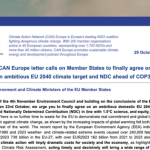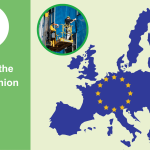The spotlight that was shining on the COP26 summit may have faded but the lack of breakthrough achievements that are desperately needed to halt dangerous climate change are still glaring. Despite commitments made by different countries, including the EU, in Glasgow, current policies and targets are projected to be widely insufficient to achieve the Paris Agreement goal. Regarding buildings, this year’s COP brought to the global stage the role they can and should play in climate action by adding a Cities, Regions and Built Environment Day onto the final agenda, raising awareness of the dire consequences of failing to act in a sector that is key to achieving a sustainable and climate-neutral future.
Despite the temporary reduction in CO2 emissions from buildings and construction in 2020 due to the COVID-19 pandemic, a recent UNEP report found that the persisting failure to unleash the deep transformation of the building sector will cause emissions and energy consumption to keep rising and aggravate the climate crisis. The decarbonisation of buildings is at a pace that is far from what is needed to be in line with the 1.5°C goal and it is about time that such a pressing issue has the political attention it so rightly deserves.
Back home, the European Commission appears to have at least in principle acknowledged the importance of building decarbonisation by launching the Renovation Wave strategy last year, but words are yet to be turned into real and bold action. The ongoing overhaul of the EU climate and energy legislation through the Fit for 55 package is Europe’s chance to get the transformation right.
To this end, the forthcoming revision proposal of the Energy Performance of Buildings Directive (EPBD), is a chance that cannot be missed to enshrine the needed ambition into legislation and include stronger measures to boost deep renovation rates and achieve a future-proof building stock .
Why buildings matter
36% of global final energy consumption and 37% of energy related CO2 emissions stem from the buildings sector globally, with an equivalent of the area of the city of Paris being added in floor space every 5 days and that of Japan every year until 2060. This indicates how big the challenge is and how urgent it is to ensure action that addresses both the existing inefficient stock and the construction sector at large.
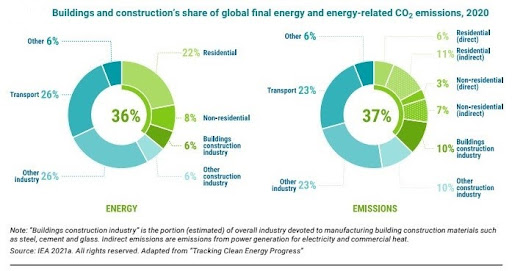
The situation doesn’t look much better if one puts the EU context under the microscope. European buildings are major contributors to greenhouse gas emissions and energy consumption, not to mention their impact on air pollution, as they add over half of the total primary emissions of fine particulate matter to the air. Despite the relative improvements of new buildings’ energy performance, existing inefficient and polluting buildings still amount to the vast majority of the stock and it is estimated that up to 90% of them will still be standing in 2050. Without deep renovation of current buildings and the acceleration of the shift towards 100% renewable energy, the vast energy saving and emissions reduction potential of the sector will remain largely untapped, thus undermining the achievement of the EU climate and energy targets.
The solutions needed
To keep the 1.5°C goal alive, the EU must endeavor to achieve climate neutrality as soon as possible, no later than 2040. The building sector should be central to this effort and to any meaningful decarbonisation strategy, first and foremost with a view to reduce its energy wastage. According to the civil-society-led Paris Agreement Compatible (PAC) scenario, the EU’s overall final energy demand should be halved by 2050. The largest chunk of such a reduction should happen in buildings, which show the highest energy saving potential, particularly in the residential sector.
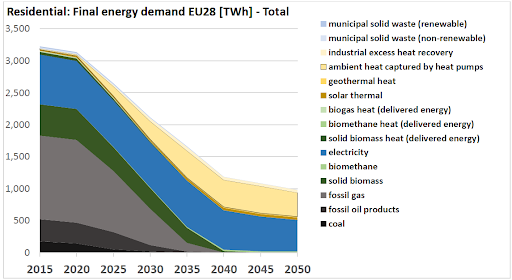
Source: PAC Scenario
Energy efficiency gains are maximised through the deep renovation of the building envelope, which improves thermal integrity, thus lowering the energy needs and the size of the heating equipment required. In this way they allow for faster deployment and better penetration of renewable heating solutions, such as renewable electricity powering heat pumps, solar thermal or renewable district heating, and leaving no role for technologies that rely for example on the use of hydrogen, which is proven to be inefficient and more expensive for buildings.
A consistent approach integrating measures to maximise energy savings and to increase the use of renewable energy sources up to the 100% mark is paramount to achieve an EU building sector compatible with the Paris Agreement. This is the only combination that can make the energy transition a success.
Warmer homes, cooler climate
Speeding up the transformation of EU buildings can bring about enormous social benefits. Inefficient, leaky and fossil-fuel-reliant homes are commonly identified among the root causes of energy poverty, a pressing social issue that looms over more than 96 million people in the EU. With inadequate housing linked to 100,000 premature deaths annually combined with a huge economic burden of over €194 billion per year in public health costs, providing better and healthier living conditions to all households is an urgent priority.
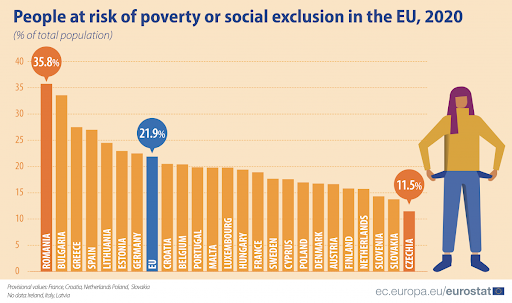
By deeply renovating existing buildings and switching to sustainable and renewable heating and cooling systems, millions of households across the EU could also be provided with a long-term solution to skyrocketing energy prices. Improving homes’ efficiency and comfort could save households over €400 on their heating bills, while substantially improving living and health standards. Securing technical and financial support to the most vulnerable, transforming the EU building stock and making it future-proof is the safest strategy to limit households’ exposure to energy price volatility and counteract future spikes.
Looking ahead
Ahead of the EPBD proposal, expected from the European Commission on 14 December, CAN Europe, together with a group of pan-European NGOs and organisations fighting for a sustainable and just transition, is calling for an ambitious revision of this key piece of legislation in line with the 1.5°C Paris Agreement goal to ensure a clean, healthy and sustainable built environment for all.
In a nutshell, this includes:
- An EPBD policy framework aligned with the 1.5°C commitment, including national long-term planning towards the achievement of a highly energy efficient, sustainable and fully renewable based building stock;
- Mandatory Minimum Energy Performance Standards (MEPS) for all existing buildings with a view to bring them to the highest level of energy performance through deep renovation and ensure better living conditions for all those living in energy poverty;
- Measures to address the whole lifecycle of buildings in order to minimise both operational and embodied emissions, introducing sustainability and circularity requirements for new construction and renovation;
- Strengthened provisions on new buildings to ensure they are highly energy efficient, sustainable and 100% fossil-fuel-free by 2025 at the latest;
- Better data and information on the EU building stock through strengthened tools such as Energy Performance Certificates (EPCs).
More information on CAN Europe’s key demands on the EPBD can be found in our recent policy briefing.
The Fit for 55 package, and particularly the EPBD revision, is the best and timely opportunity to inject ambition into the EU building policy framework and kickstart the transformation of the sector. Timid steps forward are insufficient when the clock is ticking on the climate emergency.

